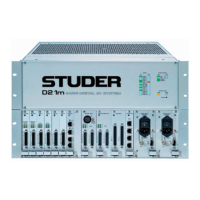D21m System
2-2 Introduction Date printed: 11.07.07
any audio channels within the MADI link. Additionally, an RS422 signal can
be “tunneled” through the MADI connection. In this way e.g. a MIDI device
can be connected to the remote I/O box and fi nd the “extension” connector
on the hub frame next to the core again.
Notes: Unlike the Studer D19m I/O system, the D21m system is engineered as an
I/O system for use together with a Studer digital console, i.e., using the D21m
system as a “standalone” analog-to-digital or digital-to-analog converter only
works if MADI I/O is used on the digital side; for more information on this
subject please
refer to chapter 5.7. Inserting, e.g., an AES/EBU card and a
Line input card and getting the A/D-converted signal out of the AES/EBU
card directly is not possible. This can be done only if the audio is routed with
a DSP core. Since the MADI signal to the D21m remote I/O box is used to
synchronize the unit, a stable, low-jitter MADI signal is necessary in order
to reach maximum audio quality. This is guaranteed by Studer equipment.
However, two I/O boxes can be interconnected using MADI, where one of
them must be switched to “Master” mode. In such a case up to 64 audio chan-
nels may be transmitted between two frames (applicable for MADI HD cards
1.949.411.23, 1.949.413.22, 1.949.414.20, or newer).

